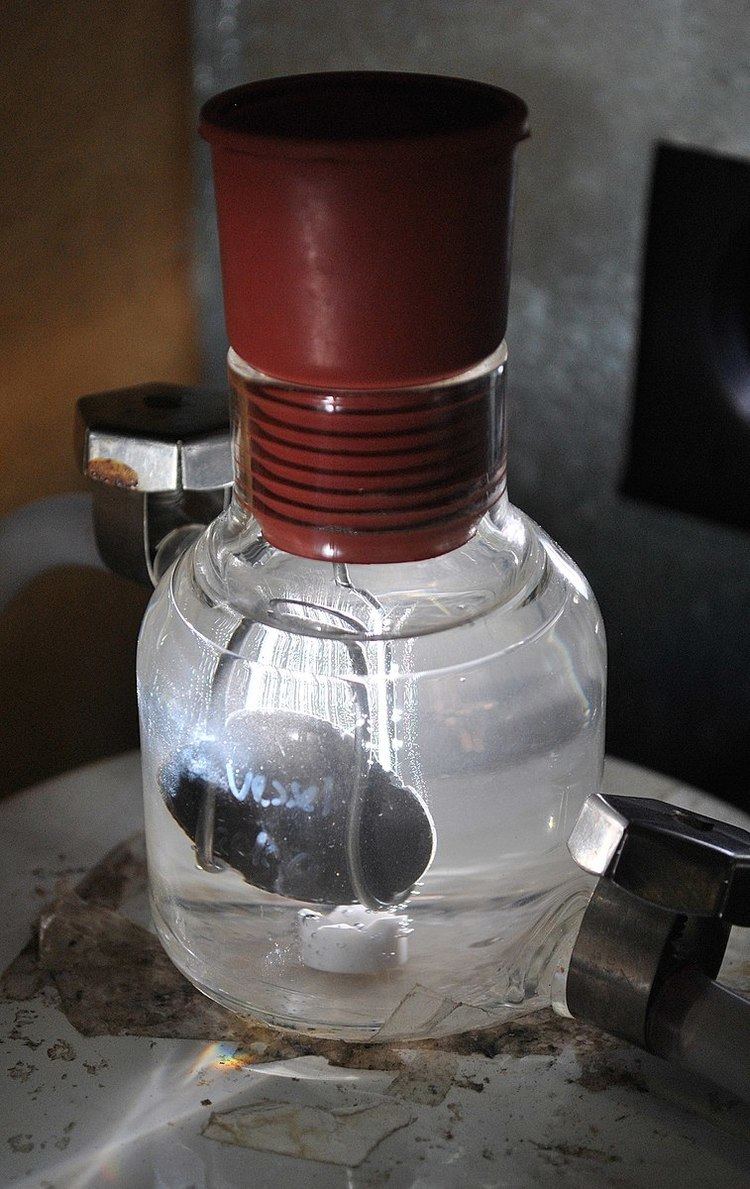 | ||
In chemistry, photocatalysis is the acceleration of a photoreaction in the presence of a catalyst. In catalysed photolysis, light is absorbed by an adsorbed substrate. In photogenerated catalysis, the photocatalytic activity (PCA) depends on the ability of the catalyst to create electron–hole pairs, which generate free radicals (e.g. hydroxyl radicals: •OH) able to undergo secondary reactions. Its practical application was made possible by the discovery of water electrolysis by means of titanium dioxide.
Contents
Homogeneous photocatalysis
In homogeneous photocatalysis, the reactants and the photocatalysts exist in the same phase. The most commonly used homogeneous photocatalysts include ozone and photo-Fenton systems (Fe+ and Fe+/H2O2). The reactive species is the •OH which is used for different purposes. The mechanism of hydroxyl radical production by ozone can follow two paths.
O3 + hν → O2 + O(1D)O(1D) + H2O → •OH + •OHO(1D) + H2O → H2O2H2O2 + hν → •OH + •OHSimilarly, the Fenton system produces hydroxyl radicals by the following mechanism
Fe2+ + H2O2→ HO• + Fe3+ + OH−Fe3+ + H2O2→ Fe2+ + HO•2 + H+Fe2+ + HO• → Fe3+ + OH−In photo-Fenton type processes, additional sources of OH radicals should be considered: through photolysis of H2O2, and through reduction of Fe3+ ions under UV light:
H2O2 + hν → HO• + HO•Fe3+ + H2O + hν → Fe2+ + HO• + H+The efficiency of Fenton type processes is influenced by several operating parameters like concentration of hydrogen peroxide, pH and intensity of UV. The main advantage of this process is the ability of using sunlight with light sensitivity up to 450 nm, thus avoiding the high costs of UV lamps and electrical energy. These reactions have been proven more efficient than the other photocatalysis but the disadvantages of the process are the low pH values which are required, since iron precipitates at higher pH values and the fact that iron has to be removed after treatment.
Heterogeneous photocatalysis
Heterogeneous catalysis has the catalyst in a different phase from the reactants. Heterogeneous photocatalysis is a discipline which includes a large variety of reactions: mild or total oxidations, dehydrogenation, hydrogen transfer, 18O2–16O2 and deuterium-alkane isotopic exchange, metal deposition, water detoxification, gaseous pollutant removal, etc.
Most common heterogeneous photocatalysts are transition metal oxides and semiconductors, which have unique characteristics. Unlike the metals which have a continuum of electronic states, semiconductors possess a void energy region where no energy levels are available to promote recombination of an electron and hole produced by photoactivation in the solid. The void region, which extends from the top of the filled valence band to the bottom of the vacant conduction band, is called the band gap. When a photon with energy equal to or greater than the materials band gap is absorbed by the semiconductor, an electron is excited from the valence band to the conduction band, generating a positive hole in the valence band. Such a photogenerated electron-hole pair is termed an exciton. The excited electron and hole can recombine and release the energy gained from the excitation of the electron as heat. Exciton recombination is undesirable and higher levels lead to an inefficient photocatalyst. For this reason efforts to develop functional photocatalysts often emphasize extending exciton lifetime, improving electron-hole separation using diverse approaches that often rely on structural features such as phase hetero-junctions (e.g. anatase-rutile interfaces), noble-metal nanoparticles, silicon nanowires and substitutional cation doping. The ultimate goal of photocatalyst design is to facilitate reactions between the excited electrons with oxidants to produce reduced products, and/or reactions between the generated holes with reductants to produce oxidized products. Due to the generation of positive holes and electrons, oxidation-reduction reactions take place at the surface of semiconductors. In the oxidative reaction, the positive holes react with the moisture present on the surface and produce a hydroxyl radical.
Oxidative reactions due to photocatalytic effect:
UV + MO → MO (h + e−)Here MO stands for metal oxide ---
h+ + H2O → H+ + •OH2 h+ + 2 H2O → 2 H+ + H2O2H2O2→ 2 •OHThe reductive reaction due to photocatalytic effect:
e− + O2 → •O2−•O2− + HO•2 + H+ → H2O2 + O2HOOH → HO• + •OHUltimately, the hydroxyl radicals are generated in both the reactions. These hydroxyl radicals are very oxidative in nature and non selective with redox potential of (E0 = +3.06 V)
Applications
Quantification of Photocatalytic Activity
ISO 22197 -1:2007 specifies a test method for the determination of the nitric oxide removal performance of materials that contain a photocatalyst or have photocatalytic films on the surface.
Specific FTIR systems are used to characterise photocatalytic activity and/or passivity especially with respect to Volatile Organic Compounds VOCs and representative matrices of the binders applied.
Recent studies show that mass spectrometry can be a powerful tool to determine photocatalytic activity of certain materials by following the decomposition of gaseous pollutants such as nitrogen oxides or carbon dioxide
